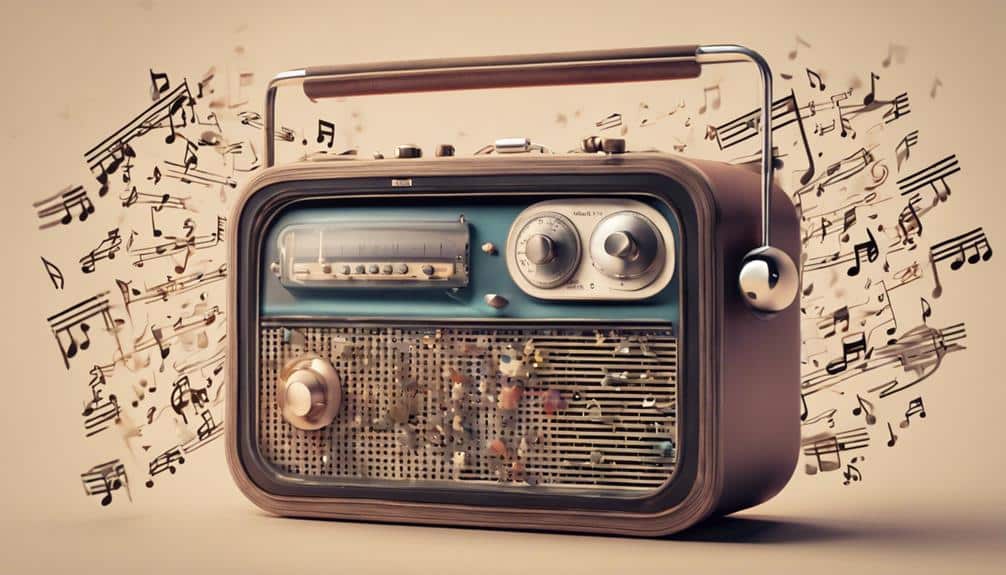The evolution of jingles from their start on radio channels to their current prevalence in online campaigns signifies a captivating yet frequently disregarded facet of advertising’s past. Initially employed during the radio’s peak, these memorable melodies effectively established a sentimental connection with viewers, leaving an enduring mark. However, as our society shifts into an increasingly online era, these jingles have transformed in their shape and purpose, becoming a vital component of contemporary marketing tactics. As we investigate this advancement, one might ponder how these jingles have sustained relevance and impact in our swiftly evolving digital realm.
Key Takeaways
- Jingles emerged in the 1920s with radio ads, gaining popularity in the 1950s to 1970s golden age.
- The transition to television in the 1950s cemented Jingles’ role in brand promotion and audience engagement.
- The advent of the internet expanded jingles to digital platforms, enhancing brand recall and optimizing for online consumption.
- AI and Machine Learning have modernized jingle production, enabling targeted marketing through customized jingles.
- Social media platforms and influencer marketing are vital for modern jingle dissemination, fostering brand loyalty and engagement.
Origins of Advertising Jingles
The origins of advertising jingles can be traced back to the 1920s, during the early days of radio advertisements. These simple yet catchy tunes were used creatively to promote products and services. Brands like Wheaties and Coca-Cola pioneered this advertising strategy, using jingles to capture consumer attention and establish strong brand identities. The role of a jingle writer during this time was significant, as they crafted memorable melodies that enhanced brand recognition and formed personal connections with consumers.
Radio was the primary communication medium at the time, and consequently, jingles became an integral part of radio advertising. The success of this approach laid the groundwork for what would later become the golden age of jingles, a period that saw the use of jingles evolve and become deeply ingrained in American popular culture.
Despite the advent of digital campaigns and the shift in advertising trends, the impact of jingles on brand identities remains robust. Jingles have evolved, adapting to the changing times and technologies while maintaining their core purpose of resonating with the audience and reinforcing brand recall. This evolution of jingles, from the early radio days to the current digital era, demonstrates their enduring appeal and effectiveness in advertising.
The Golden Age of Jingles
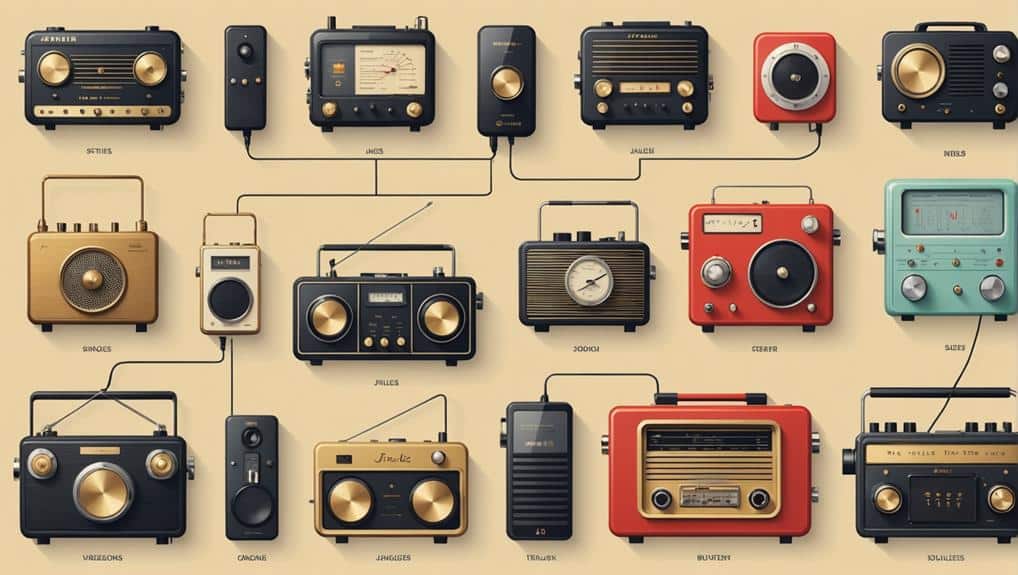
From the 1950s to the 1970s, the golden era of advertising tunes marked a remarkable period in advertising and American pop culture. During this era, TV commercials were dominated by catchy melodies that swiftly captivated audiences, embedding themselves as unforgettable tunes in viewers’ minds. These tunes were often the creation of highly skilled jingle writers who used fundamental composition strategies to craft melodies that resonated deeply with audiences.
Brands such as Pepsi-Cola and Oscar Mayer utilized the power of tunes to establish an emotional bond with consumers. These iconic melodies resonated deeply with audiences and significantly enhanced brand recognition. The songs of this golden era transcended the mere goal of selling products. They became integral elements of brand storytelling, forging a distinct identity that sets brands apart in a competitive market.
During this period, they made a notable shift in advertising strategies, where jingles were no longer secondary but central to consumer engagement. Each melody was carefully crafted, with the melodic rhythm and lyrical content serving a unique purpose: to create a lasting impression. The golden era of jingles, thus, showcased the effectiveness of music in advertising, highlighting its ability to establish emotional connections and enduring brand impressions.
Transition to Television Jingles
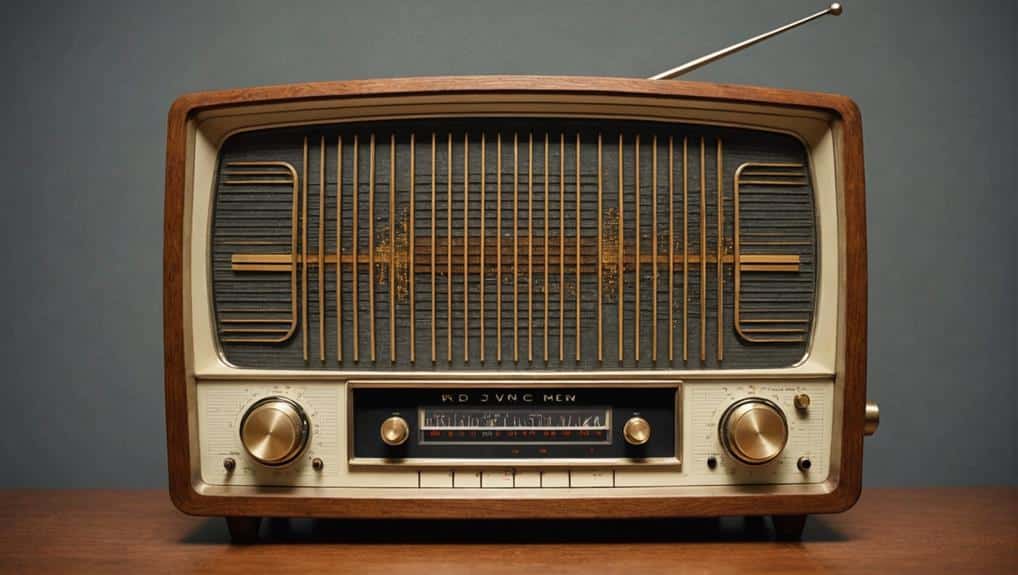
The growing popularity of television in the 1950s marked a significant change in the landscape of advertising jingles. This shift to television jingles allowed advertisers to reach a larger audience and improve brand recognition. Brands like Coca-Cola and McDonald’s capitalized on this medium, creating iconic jingles that resonated with audiences. These jingles, characterized by catchy tunes and memorable lyrics, were meticulously crafted to engage viewers effectively.
The golden age of television advertising, from the 1950s to the 1970s, solidified jingles as a vital tool for brand promotion. During this period, jingles evolved from simple melodious hooks to complex musical compositions, incorporating elements of popular music genres to appeal to a broader demographic.
| Period | Medium | Effect on Brand Recognition |
|---|---|---|
| 1950s-1970s | Television | Increased audience reach and improved brand recognition |
| 1970s-Present | Television | Continued use of jingles for brand promotion, with a focus on catchy tunes and memorable lyrics |
| Future | Television | Potential for further evolution of jingles to cater to changing viewer preferences |
This change demonstrates the enduring power of jingles in shaping audience perceptions and driving brand loyalty.
Impact of the Internet on Jingles

With the emergence of the internet, the reach of jingles has dramatically expanded, surpassing the boundaries of traditional media to embrace digital platforms. This online impact has shaped the evolution of jingles in multiple ways, encouraging their optimization for online consumption and facilitating their spread through online streaming services and social media platforms. Notably, integrating AI and Machine Learning in jingle production has transformed music creation, effectively generating compositions and identifying resonating musical elements to boost the effectiveness of digital campaigns Incorporation. of AI.
The shift towards digital platforms has led to several key developments:
- Shorter jingle formats with catchy hooks are now preferred to cater to fast-paced online consumption behaviors.
- Internet analytics track jingle performance and audience engagement, enabling advertisers to adjust their campaigns for better results.
- The rise of customized jingles, tailored to specific or segmented consumer preferences, has ushered in a new era of targeted marketing. This customization trend aligns with the broader marketing shift towards creating connections through local landmarks or events and building familiarity and trust with personalized content.
- With their vast user base and interactive capabilities, social media platforms have become popular channels for disseminating jingles and engaging audiences.
Jingles Going Digital
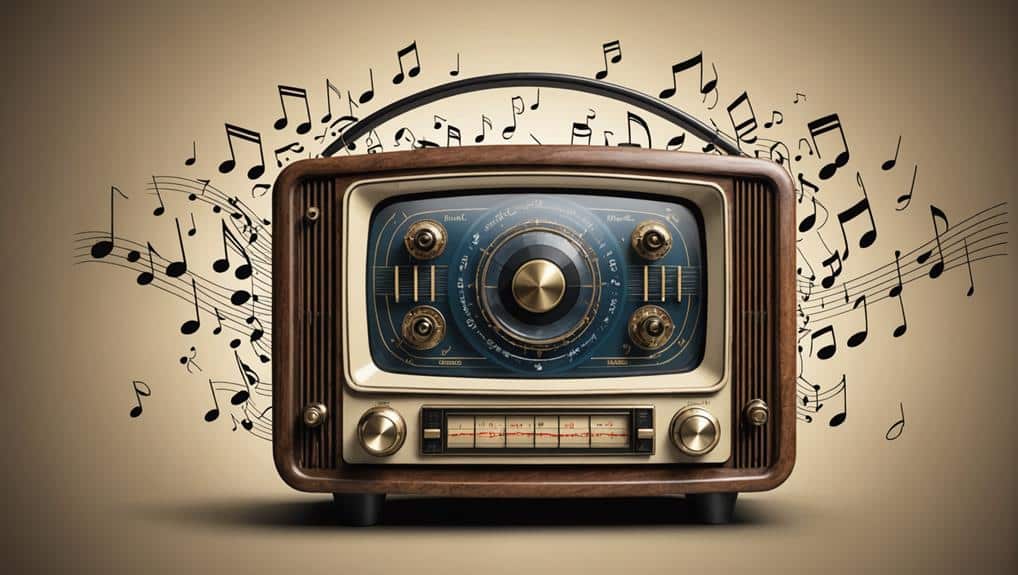
Jingles have undergone a significant transformation in the digital age, shifting from traditional radio spots to dynamic digital campaigns. Brands have unearthed the advantages of having a jingle, such as improved brand recall and distinction from competitors. The migration of jingles in advertising to the digital world has utilized technology to interact with consumers through diverse online platforms, reaching a wider audience than ever.
The transformation of jingles to digital tunes signifies a strategic change in marketing approaches, with brands adjusting their advertising themes to fit digital formats. This adjustment is not just a shift in medium but also in approach, integrating interactive elements and tailored experiences for consumers. A well-crafted digital jingle can showcase a product’s distinct characteristics, making it stand out in the crowded digital sphere.
The rise of digital campaigns has brought about an era of targeted advertising, where brands can customize their messages to specific demographics. Utilizing data-driven insights allows for more precise and immediate engagement with audiences.
Furthermore, digital jingles give brands an unparalleled chance to create memorable audio experiences. These experiences, designed with the contemporary digital consumer in mind, resonate and engage deeper, ensuring the brand’s message is heard and remembered. Hence, the transformation of jingles into the digital domain represents a technological shift and a revolution in advertising strategy.
Psychological Influence of Jingles

The psychological impact of jingles is substantial, molding both feelings responses and brand perception among consumers. Jingles can generate strong sentimental connections through their tuneful arrangement, boosting brand recall and nurturing consumer loyalty. Integrating clear communication and unforgettable brand expressions into a jingle can enrich this sentimental connection, guaranteeing that the brand remains foremost in consumers’ thoughts. Besides, the significance of jingles in shaping consumer perception of a brand is crucial, with the capacity to propel recognition and impact purchase choices.
Emotional Impact of Jingles
Immersing consumers in a world of melodies and rhythms, jingles play a pivotal role in advertising by evoking solid feelings. They penetrate deep into consumers’ psyches, activating brain areas linked to reward processing, thereby creating a profound impact. This boosts brand recall and fosters positive associations with advertised products.
The catchy tunes and sentimental connections they establish make jingles easily memorable. They thereby influence consumer behavior toward increased brand recognition and loyalty. Well-crafted jingles leave an indelible imprint on consumer memory, serving as an invaluable tool for brand promotion.
Here is a visual representation of how jingles impact consumers with strong feelings:
- Jingles activate reward processing areas in the brain, eliciting a significant response.
- The music in jingles improves brand recall and forms favorable associations with the advertised product.
- Catchy tunes and sentimental connections make jingles easily memorable, influencing consumer behavior.
- The impact of jingles leads to increased brand recognition and loyalty.
Jingles and Brand Perception
In advertising, tunes hold a potent sway over brand perception. They utilize their unique abilities to create sentimental, solid associations with brands. This heartfelt bond triggers consumer behavior, guiding preferences towards products or services that resonate with individual experiences or aspirations.
Scientific research underpins these observations, revealing that the musical elements in tunes activate specific brain areas related to memory and reward processing. This memory activation enriches brand recall, making tunes more effective than spoken advertisements for brand recognition. Indeed, the power of a well-crafted tune is its capacity to linger in the consumer’s mind, imprinting an enduring brand image.
The psychological impact of tunes extends beyond mere recall. Tunes foster a deeper connection with consumers by evoking positive feelings, becoming integral to brand identity. This sentimental engagement cultivates brand loyalty, as consumers associate the tune’s melody and lyrics with the brand’s values and promises. Hence, tunes serve as strategic tools in shaping brand perception, demonstrating the remarkable interplay of music, psychology, and marketing in influencing consumer decisions.
Composition Techniques for Jingles
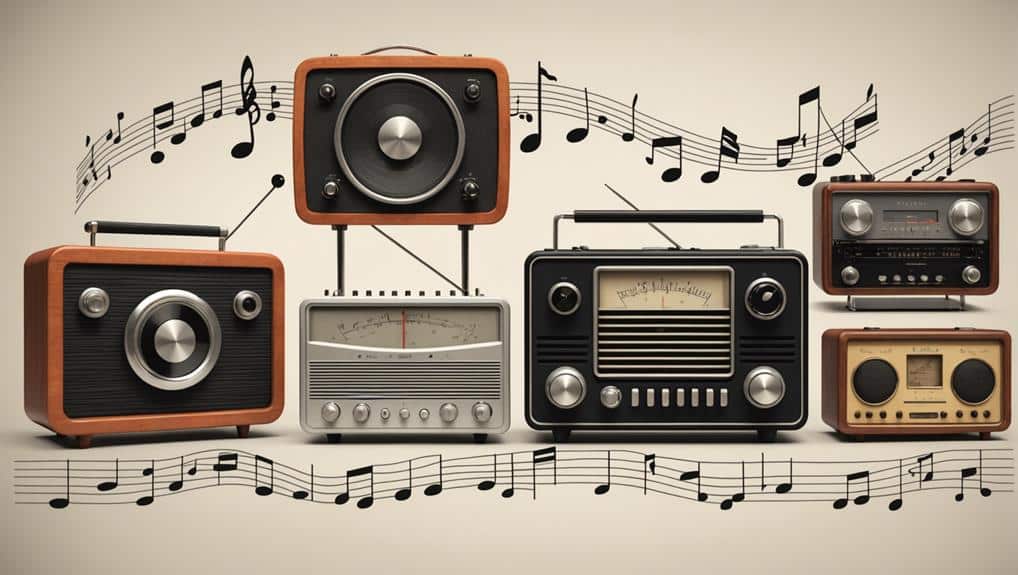
The art of composing jingles involves a delicate balance of melodic structure, sentimentally resonant lyrics, and the integration of brand character. The melody and lyrics must work in tandem to catch the listener’s ear and evoke feelings that align with the brand’s identity. Consequently, the brand’s character must be deftly woven into the jingle to guarantee its message resonates with its target audience.
Melodic Structure and Lyrics
With an uncanny talent for delving into one’s awareness, jingles utilize uncomplicated yet captivating tunes that one can effortlessly recall and link with a brand. These unforgettable musical pieces are carefully crafted with a melodic framework that captures the listener’s attention and leaves a lasting impact. The strategic use of musical elements such as rhythm, harmony, and repetition enriches the memorability and influence of these jingles.
The guidelines for effective jingle composition include:
- Crafting resonant lyrics that encapsulate the brand message in a remarkable manner
- Designing a melodic framework that swiftly grabs attention and leaves a lasting impression on the listener
- Utilizing crucial music elements like rhythm, harmony, and repetition to amplify the jingle’s memorability
- Tailoring the tune to reflect the brand’s identity and principles and resonate with the target audience
Composing jingles combines captivating tunes, concise and resonant lyrics, and a well-considered melodic framework. This powerful combination effectively conveys the brand message to the target audience, serving as a potent marketing tool.
Emotional Resonance in Jingles
Jingles tap into the power of music to create a deep connection beyond mere brand recognition. This heartfelt resonance is achieved through a blend of catchy tunes and meaningful lyrics, conveying a brand’s core message and ethos.
Composition techniques play a pivotal role in enhancing the sentimental impact of jingles. Specific chord progressions and tempo variations add depth and dimension to the melody, while vocal harmonies infuse a sense of unity and cohesion. These tactics amplify the jingle’s moving quality, making it an effective tool for eliciting desired emotional responses.
Familiar musical elements such as hooks and repetition are vital in jingle composition. Their strategic Incorporation strengthens the jingle’s memorability and deepens the heartfelt connection with the audience. The aim is to evoke specific emotions—joy, nostalgia, excitement—that resonate with the target demographic.
Crafted with precision, jingles trigger positive emotional responses, increasing brand recall and consumer engagement. Therefore, their heartfelt resonance is not just a by-product but a calculated outcome of careful composition.
Incorporating Brand Personality
Understanding a brand’s essence and reflecting it in a jingle’s composition is an art that requires a deep understanding of both music and marketing. This process involves composing melodies that vividly embody the brand’s fundamental values and identity. To achieve this, jingles utilize specific musical elements that align with the brand character, delivering heartfelt messages that resonate with the target audience.
The strategic composition of jingles is hinged on four key factors:
- Crafting catchy tunes that mirror the brand’s character and spirit.
- Composing relatable lyrics that depict the brand’s fundamental values.
- Incorporating memorable hooks that boost brand recall and recognition.
- Selecting musical elements that evoke emotions in line with the brand’s identity.
These techniques create jingles that catch the target audience’s attention and instill a sense of familiarity and emotional connection with the brand. This fusion of music and marketing gives jingles a remarkable ability to convey brand character and establish a strong brand identity, thereby creating lasting connections with consumers.
Modern Innovations in Jingles
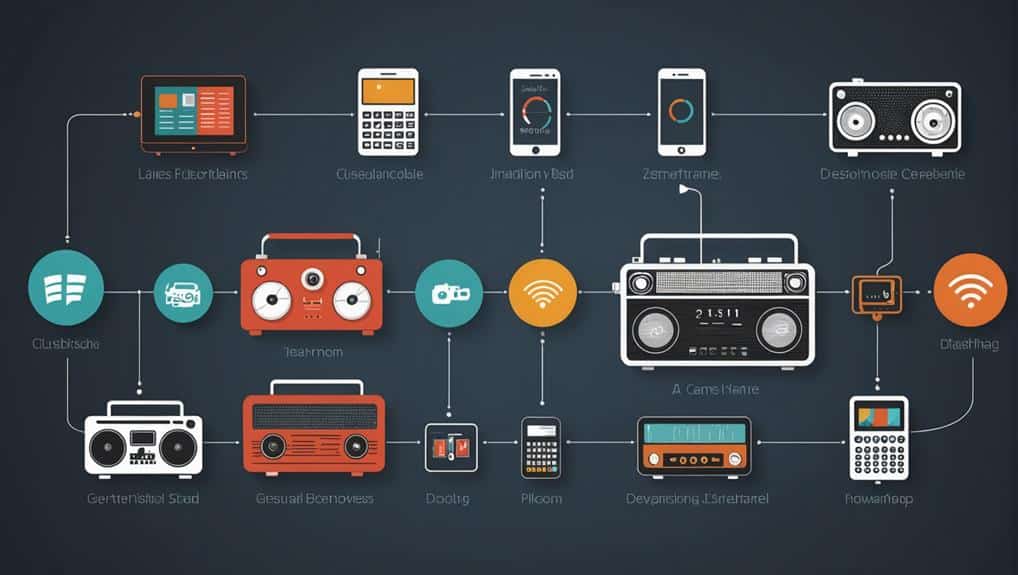
As we enter the digital era, the landscape of catchy tunes is undergoing significant transformation. An emerging trend is the integration of jingles into virtual and augmented reality experiences, which enhances consumer engagement. Brands also experimented with interactive tunes, creating distinct brand experiences that resonate with contemporary audiences captivated by technological advancements.
The rise of influencer marketing has paved the way for creative uses of jingles, capitalizing on the popularity and reach of social media personalities. Besides, tunes are evolving to adapt to changing consumer preferences and cultural influences, showcasing the flexible nature of this promotional tool in the digital age.
The table below provides an overview of the critical modern advancements in jingles:
| Advancement | Purpose | Example |
|---|---|---|
| Interactive Tunes | Enhance consumer engagement | Brand-specific mobile apps |
| Virtual Reality Experiences | Create immersive brand experiences | VR product launches |
| Augmented Reality | Blend physical and digital experiences | AR-enabled product packaging |
| Influencer Marketing | Leverage social media reach | Brand collaborations with influencers |
| Adapting to Changing Preferences | Remain relevant and appealing | Culturally sensitive and diverse tune themes |
These developments underline jingles’ sustained relevance and adaptability in contemporary marketing strategies.
Future Trends in Jingle Creation

As we look towards the future of jingle creation, emerging technologies, such as virtual reality, are starting to play a crucial role. These immersive experiences are being utilized to enhance consumer engagement and effectively imprint brand messages. At the same time, the growth of influencer marketing sees an exciting intertwining of famous online figures with catchy jingles, creating a new frontier in brand promotion.
Virtual Reality Jingles
While traditional jingles have relied on catchy tunes and memorable lyrics, the future of jingle creation is taking a significant leap into the digital age with virtual reality melodies. This groundbreaking approach transforms how brands connect with their audiences, providing immersive brand experiences unlike before.
Virtual reality melodies offer enriched consumer engagement through memorable and impactful interactive elements. They represent a new frontier in the digital realm, where the boundaries between reality and digital are blurred to create a distinct brand experience that resonates with consumers on a deeper level.
- Virtual reality melodies are paving the way for more engaging brand campaigns.
- They provide immersive brand experiences that are memorable and impactful.
- This groundbreaking approach enriches consumer engagement.
- Virtual reality melodies are transforming the digital realm.
As this trend continues to evolve, it’s evident that virtual reality melodies are not just a passing trend but a significant step forward in jingle creation. This advancement offers a new way for brands to connect with their audiences, providing a new level of interactivity and immersion that is set to reshape the future of advertising jingles.
Influencer Marketing Jingles
In the dynamic advertising landscape, influencer marketing jingles are becoming a powerful tool for brands aiming to captivate and engage their audiences. By leveraging famous personalities, these jingles are more effective at promoting brands and products with genuineness and credibility. Brands can tap into a broader audience and niche markets through influencer marketing jingles.
The rise in influencer marketing jingles is primarily due to their ability to create engaging and shareable content. They offer a personalized approach to connect with the target audience, allowing brands to stay relevant in the fast-paced digital era.
The table below provides further insights:
| Key Aspect | Why It Matters |
|---|---|
| Genuineness and Credibility | Influencers add a level of trust to the brand’s message |
| Broad Audience Reach | Influencer’s followers provide a ready audience |
| Engaging Content Creation | Influencers can create distinctive, shareable jingles |
Influencer marketing jingles are not just a trend; they represent the future of jingle creation. Combining famous personalities, genuineness, credibility, and engaging content is a powerful strategy for reaching broader and niche markets.
Jingles and Brand Recognition
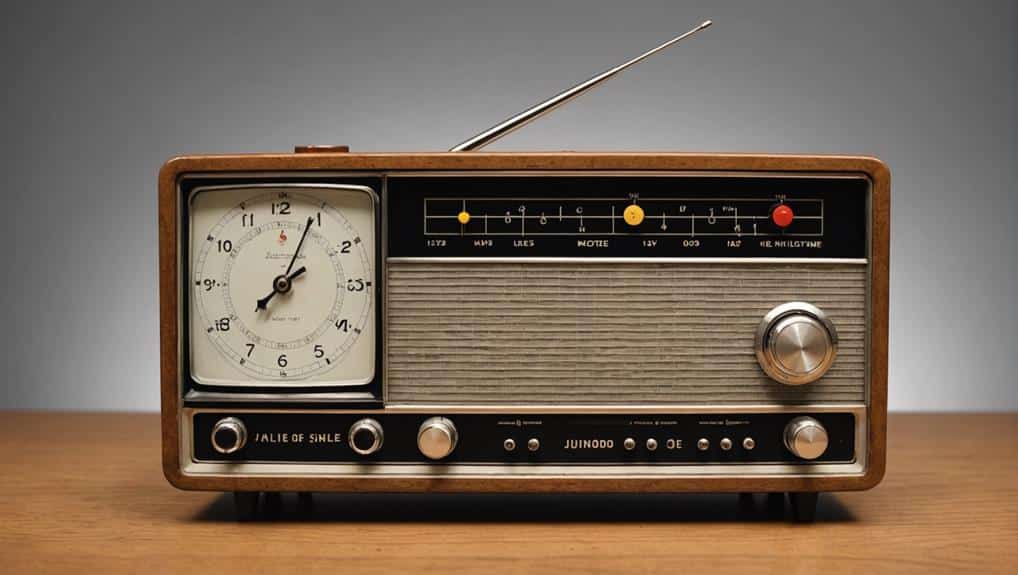
Catchy tunes have emerged as a potent tool for establishing brand familiarity. Their impact spans from classic radio advertisements to modern digital campaigns, consistently showcasing their capacity to shape consumer actions and nurture brand allegiance.
Catchy tunes employ a distinct fusion of sentimental appeal and repetitive structure to form a lasting impression on consumers. This combination boosts brand familiarity and strengthens brand allegiance.
- Catchy tunes activate brain regions associated with reward processing, heightening brand remembrance.
- Their repetitive structure reinforces brand communication, making it more memorable and reliable.
- Well-crafted tunes evoke positive feelings, nurturing brand allegiance.
- Tunes enrich brand involvement and recognition by fostering a sense of shared community.
Furthermore, tunes hold the potential to influence consumer actions by resonating with their principles, thereby forging deeper brand connections. As we continue to investigate the evolution of tunes, the emphasis on brand familiarity highlights their enduring significance and effectiveness in shaping consumer preferences and behaviors. Nevertheless, tunes’ sentimental impact emphasizes their power, a topic we will explore in the next section.
Emotional Impact of Jingles
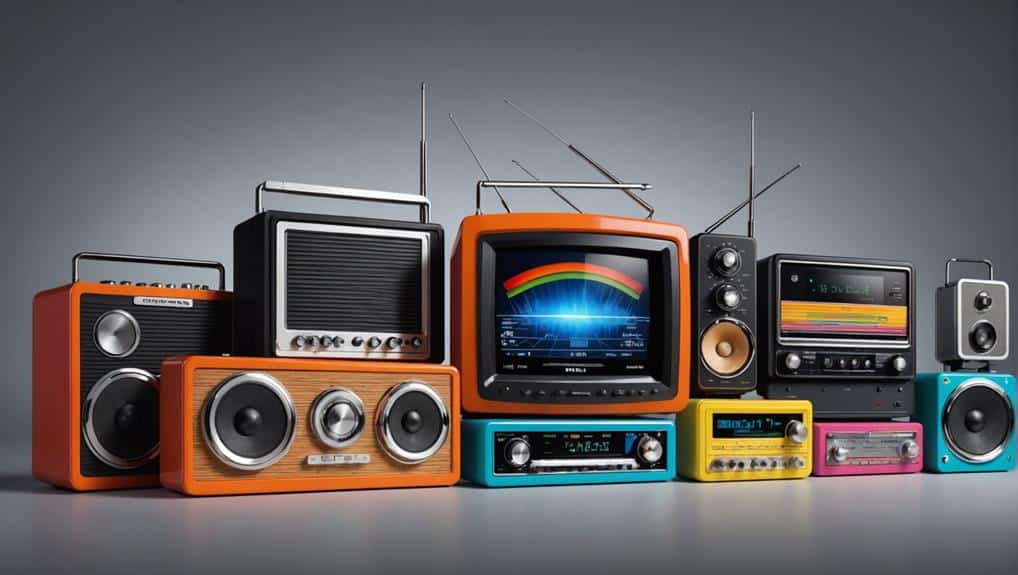
The impactful effect of jingles cannot be underestimated in the world of brand marketing. With their catchy tunes and memorable lyrics, jingles evoke strong consumer feelings. These sentiments form powerful brand connections, bridging the consumers’ impressions and the brand.
Scientific studies affirm the role of music in activating brain areas associated with feelings and memory, thereby enhancing ad effectiveness. Jingles serve as a potent tool in fostering increased brand recall. An appealing jingle remains etched in consumers’ minds, making the brand memorable and influencing consumer behavior.
This heartfelt resonance can drive purchase decisions, shaping consumers’ preferences toward brands with positive emotional associations. Moreover, jingles foster brand loyalty. Consumers tend to align themselves with brands that evoke positive feelings, indicating a direct correlation between the impact of jingles and brand loyalty.
Jingles in Influencer Marketing

Leveraging the power of influential figures, influencer marketing has emerged as a strategic method to increase brand visibility and credibility. By integrating catchy tunes into this approach, brands are now creating more memorable and engaging content that resonates with their audience.
In influencer marketing, jingles are catchy melodies embedded in consumers’ minds. When influencers, often seen as trusted online personalities, integrate these jingles into their content, it amplifies brand awareness among their vast follower base.
- Brands collaborate with influential online personalities to promote their products or services through catchy tunes.
- Jingles creates memorable and engaging brand messaging that resonates with the influencers’ audience.
- Using jingles in influencer marketing can boost brand recognition and consumer engagement.
- Jingles offers a distinctive and creative way to connect with audiences and foster brand loyalty.
Influencer marketing, coupled with the power of jingles, has indeed carved a new path in digital marketing strategies. It’s about promoting a product or service and creating a meaningful connection that drives engagement and brand loyalty.
Jingles in Virtual Reality
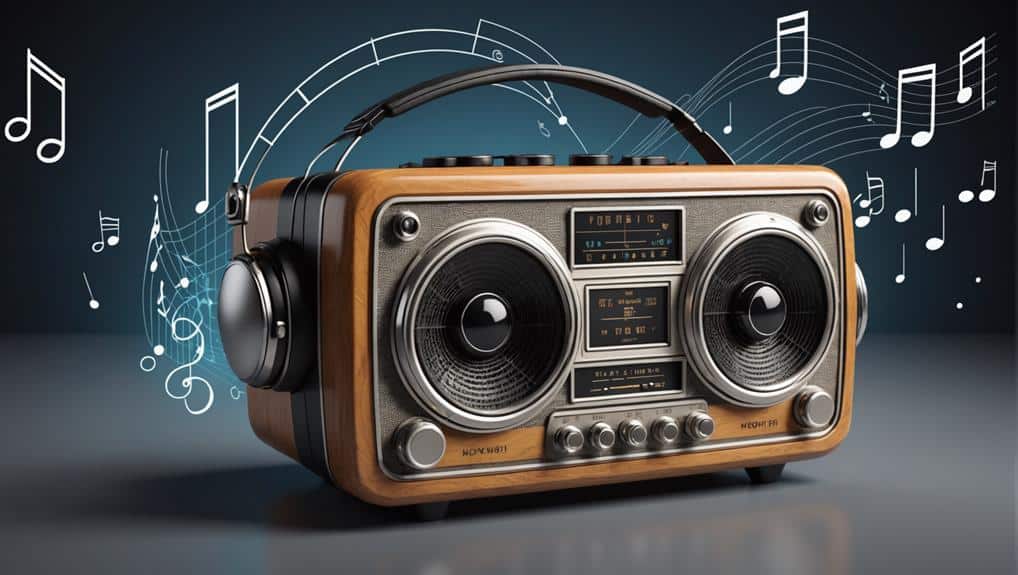
Venturing beyond influencer marketing, jingles have found a new platform in virtual reality. Integrating virtual reality jingles into this groundbreaking medium enriches consumer engagement by creating dynamic and unforgettable immersive brand experiences.
Brands are harnessing virtual reality’s opportunities for creative storytelling and tailored brand experiences. Developing interactive jingles enables higher audience interaction, deepening sentimental connections with consumers. This approach provides a distinct, captivating experience that surpasses traditional advertising methods.
Virtual reality jingles epitomize the forefront of advertising, leveraging technological advancements to pioneer a fresh way of connecting with audiences. They offer a creative fusion of artistry and technology, crafting compelling narratives that resonate with consumers on a deeper, more significant level.
Essential Insights to RememberConclusion
The transformation of advertising jingles from radio to digital platforms highlights their lasting effectiveness in brand promotion. Despite the expected objection that the prevalence of online content may weaken their influence, jingles have shown adaptability, utilizing creative techniques for best reach and relevance. Their distinct ability to evoke sentimental connections and aid brand recognition forms the foundation of their ongoing relevance in modern marketing tactics, including influencer marketing and virtual reality, showcasing their essential role in the changing advertising scene.

Cary Reich is a master jingle-writer with over 35 years of experience creating brand‐defining melodic slogans and audio identities. Since 1985, Cary has crafted memorable campaigns for both national and local clients — including Budweiser, Firestone, Gold’s Gym, Goodwill, and YMCA — blending creative vision and musical expertise to make businesses not just heard, but remembered.

